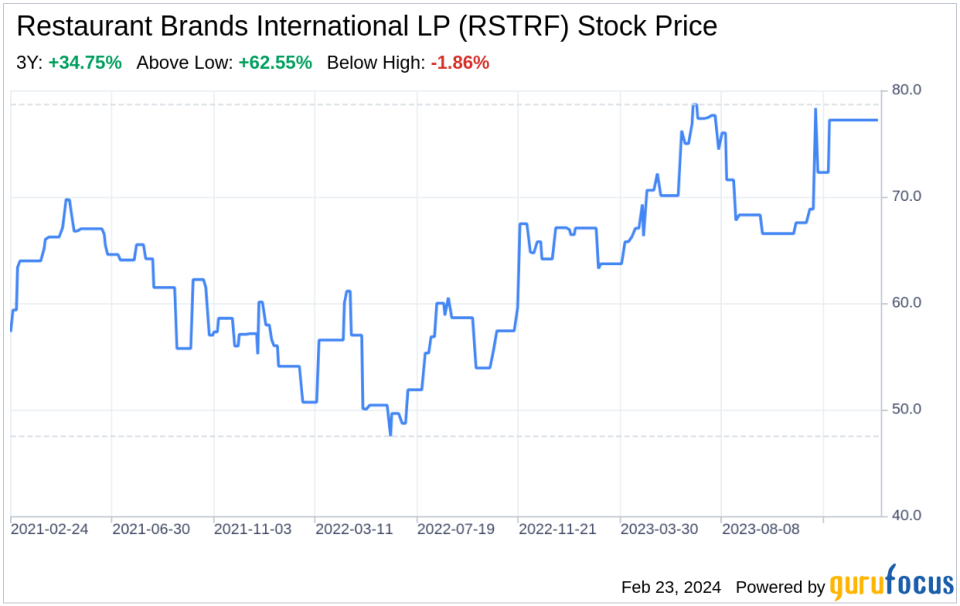Decoding Restaurant Brands International LP (RSTRF): A Strategic SWOT Insight
Comprehensive SWOT analysis based on the latest 10-K filing.
Strategic evaluation of strengths, weaknesses, opportunities, and threats.
Data-driven insights to inform investment decisions.
Expert analysis of financial performance and market trends.
On February 22, 2024, Restaurant Brands International LP (RSTRF) filed its annual 10-K report, providing a detailed account of its financial performance and strategic direction. As a Canada-based firm with a strong presence in the quick-service restaurant industry, RSTRF operates through its renowned segments: Tim Hortons, Burger King, and Popeyes Louisiana Kitchen. The company's revenue streams are diverse, including franchise revenues, property revenues, and sales at company-owned restaurants, with a significant contribution from Tim Hortons' supply chain operations. The 10-K filing reveals that RSTRF has maintained a robust financial position, with an aggregate market value of Class B exchangeable limited partnership units held by non-affiliates reaching C$1,043.40 million as of June 30, 2023. This financial overview sets the stage for a deeper SWOT analysis, providing investors with a comprehensive understanding of RSTRF's competitive edge and potential challenges.

Strengths
Brand Power and Market Recognition: Restaurant Brands International LP (RSTRF) boasts a portfolio of powerful and recognized brands, including Tim Hortons, Burger King, and Popeyes Louisiana Kitchen. These brands have a global presence and are synonymous with quality and convenience in the quick-service restaurant sector. The company's brand strength is reflected in its ability to generate substantial franchise revenues, which primarily consist of royalties based on sales reported by franchised restaurants. This brand equity not only attracts customers but also potential franchisees, contributing to RSTRF's expansive network and market penetration.
Strategic Acquisitions and Franchisee Relationships: RSTRF's recent agreement to acquire the remaining equity interests of its largest U.S. Burger King franchisee, Carrols Restaurant Group, Inc., exemplifies its strategic growth initiatives. This acquisition, expected to complete in the second quarter of 2024, will add approximately 1,020 Burger King restaurants and 60 Popeyes restaurants to its portfolio. RSTRF's strategy to remodel and refranchise the majority of the acquired restaurants underscores its commitment to enhancing the guest service experience and driving franchisee profitability, which is crucial for long-term brand growth.
Weaknesses
Dependence on Franchisee Performance: While RSTRF's franchising model is a significant strength, it also presents a vulnerability. The company's success heavily relies on the performance and profitability of its franchisees. If franchisees fail to maintain operational standards or face financial difficulties, it could negatively impact RSTRF's revenue streams and brand reputation. This dependence on third-party operators requires constant monitoring and support to ensure compliance with the company's high standards.
Supply Chain Concentration Risks: RSTRF's supply chain operations, particularly for Tim Hortons, involve a limited number of suppliers for certain product categories. While this allows for quality control and cost management, it also exposes the company to potential risks associated with supplier concentration. Any disruption in the supply chain, whether due to economic, environmental, or geopolitical factors, could impact RSTRF's ability to meet consumer demand and maintain its operational efficiency.
Opportunities
Technological and Digital Initiatives: RSTRF is well-positioned to capitalize on the growing trend of digitalization in the restaurant industry. The company's investment in technology, including loyalty programs and mobile ordering platforms, offers a significant opportunity to enhance customer engagement and streamline operations. As digital adoption accelerates, RSTRF's ongoing technological advancements could lead to increased sales, improved customer experiences, and operational efficiencies.
International Expansion: RSTRF's fifth segment, INTL, which includes consolidated results from each brand's international operations outside of the U.S. and Canada, presents a substantial opportunity for growth. The company's established brand presence and franchising model provide a solid foundation for expanding into new international markets. By leveraging local partnerships and adapting to regional tastes, RSTRF can tap into the vast potential of emerging economies and increase its global footprint.
Threats
Intense Competition: The quick-service restaurant industry is highly competitive, with low barriers to entry and a multitude of well-established players. RSTRF faces competition from both large international chains and local operators, which can impact market share and profitability. The company must continuously innovate and adapt to consumer preferences to maintain its competitive edge in an industry where customer loyalty can be fleeting.
Regulatory and Health Concerns: RSTRF operates in a regulatory environment that is increasingly focused on health, nutrition, and sustainability. Changes in regulations, such as those targeting high-fat, high-calorie, and high-sodium foods, could necessitate alterations in menu offerings and operational practices. Additionally, public health campaigns and consumer trends towards healthier eating could affect demand for RSTRF's products, requiring the company to adjust its product development strategies accordingly.
In conclusion, Restaurant Brands International LP (RSTRF) exhibits a strong market position with its portfolio of well-known brands and strategic growth initiatives. However, the company must navigate challenges related to its franchising model, supply chain dependencies, and the intensely competitive landscape. By leveraging its strengths, addressing its weaknesses, capitalizing on opportunities, and mitigating threats, RSTRF is poised to continue its trajectory of growth and profitability in the quick-service restaurant industry.
This article, generated by GuruFocus, is designed to provide general insights and is not tailored financial advice. Our commentary is rooted in historical data and analyst projections, utilizing an impartial methodology, and is not intended to serve as specific investment guidance. It does not formulate a recommendation to purchase or divest any stock and does not consider individual investment objectives or financial circumstances. Our objective is to deliver long-term, fundamental data-driven analysis. Be aware that our analysis might not incorporate the most recent, price-sensitive company announcements or qualitative information. GuruFocus holds no position in the stocks mentioned herein.
This article first appeared on GuruFocus.
